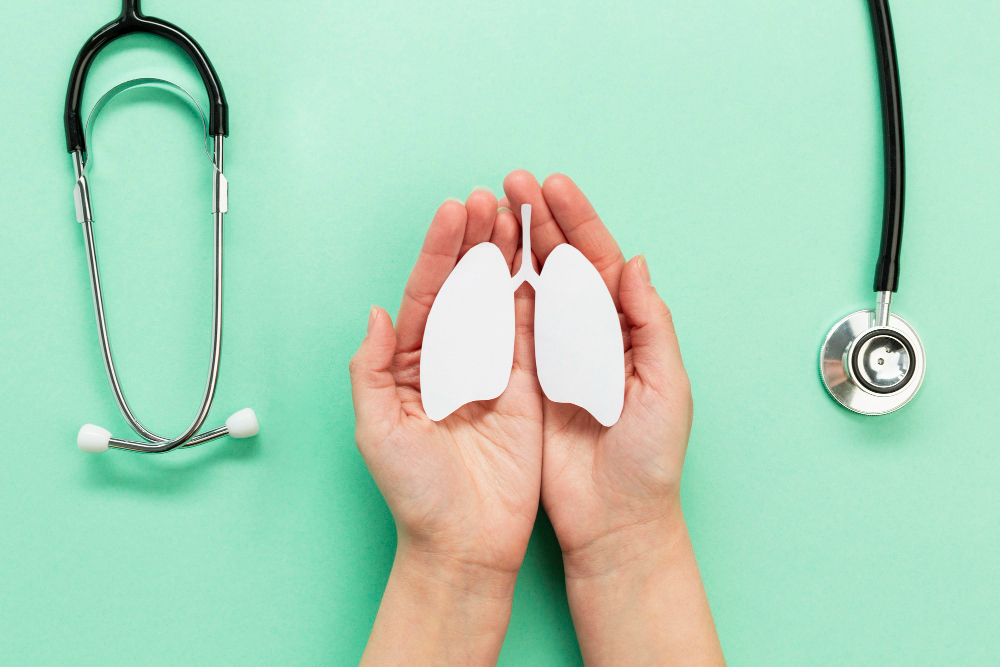Your lungs’ capacity to hold air is indicated by lung capacity. Over time, breathing exercises can help you breathe more easily.
The total volume of air that your lungs can hold is known as your lung capacity. After we reach our mid-20s, our lung function and capacity usually gradually decline with ageTrusted Source.
Certain illnesses, including asthma, can greatly accelerate the deterioration of lung function. Breathing difficulties and dyspnea result from this.
Exercises that support lung capacity can help you maintain the health of your lungs and get the oxygen your body requires.
Breathing diaphragmatically
The diaphragm, which is meant to carry out the majority of the labor-intensive breathing tasks, is activated by diaphragmatic breathing, also referred to as “belly breathing.”
Because the diaphragm is less effective and might be strengthened in those with chronic obstructive pulmonary disease (COPD), this procedure is very beneficial to them. Using the approach when well-rested is recommended.
For optimal benefits, have a respiratory therapist or physician demonstrate this exercise to you if you have COPD. Remember that although breathing exercises can eventually lessen the symptoms of COPD, there is no proof from science that they can cure the illness or damaged lungs.
The COPD Foundation suggests that you practice diaphragmatic breathing by doing the following:
Sit back or lie down, and let your shoulders drop.
Put a hand on your stomach and a second on your chest.
Take a two-second breath through your nose, allowing the air to enter your abdomen and the stomach to exit. The more movement in your stomach than in your chest is ideal.
Press your lips pursed and exhale for two seconds into your abdomen.
Repeat.
Breathing with pursed lips

By keeping your airways open for a longer period of time, breathing with pursed lips can slow down and lessen the effort involved in breathing. This enhances the exchange of carbon dioxide and oxygen in the lungs and facilitates their operation.
You can do this breathing exercise at home even if no one has taught you how to do it, and it’s usually easier for beginners than diaphragmatic breathing. You can practice it whenever you want.
To practice the breathing technique with pursed lipsReliable Source:
Breathe in slowly through your nose.
Make a pouting or going to blow on something gesture with your pursed lips.
With your lips pressed together, exhale slowly. At least twice as long should pass as it did to breathe in for this.
Repeat.
Why does one have reduced lung capacity?
Lung capacity can decline over time due to a variety of factors. Because our bodies inevitably slow down with age, ageing is usually the main factor.
Additional possible reasonsAmong the reliable sources are:
persistent lung conditions include asthma, emphysema, and COPD
being overweight
lack of physical activity abnormalities of the chest wall
possessing a high ratio of waist to hips and a vitamin D deficitdependable source pregnancyReliable Source
By age, what is the usual lung capacity?
The ability and functionality of our lungs can differ greatly from person to person and can alter over the course of our lives. The lungs have a maximum capacity of about six litres of air.
As you age, your lungs lose part of their flexibility and your breathing muscles may weaken. As a result, your lungs’ capacity to store air and their ability to exchange carbon dioxide and oxygen are reduced.
Spirometry is a technique used by doctors to assess lung capacityTrusted Source. The test’s results can be used to detect diseases like asthma and COPD and to gauge how well a treatment is working.
Tests for spirometry can reveal:
Forced vital capacity (FVC): the total amount of air you can exhale after taking a deep breath; forced expiratory volume (FEV1): the amount of air you can exhale in one second
Spirometry test results are expressed by doctors as a percentage of the “normal” value for a person with your height, age, sex, and race. If your FEV1 is 80%, for instance, you are able to exhale 80% of the air that a person with healthy lungs of the same height, age, sex, and race might exhale in one second.
Both FEV1 and FVC have normal values that are greater than 80% of the expected value (Trusted Source). Less than 80% values could indicate lung illness.
Advice on maintaining lung health

The best medicine is prevention. Maintaining the health of your lungs can help you prevent issues in the future. Here are some pointers to maintain the health of your lungs:
If you smoke, think about giving it up and stay away from irritants in the surroundings including secondhand smoke.
Consume a diet strong in fibre and high in antioxidants (Trusted Source).
Vaccinate yourself against diseases like pneumonia and the flu. This can support lung health and help avoid lung infections.
Increased exercise can aid in the correct functioning of your lungs.
Boost the quality of the air inside. Utilise devices like indoor air filters to reduce toxins including dust, mould, and artificial smells.
Frequently requested enquiries
Some commonly asked questions concerning lung capacity are listed below.
Is it possible to enhance lung capacity with breathing exercises?
Indeed, for people without underlying lung diseases, diaphragmatic breathing and other breathing exercises may help preserve or improve lung capacity. Maintaining lung function can also be aided by increasing physical exercise.
Which breathing technique is most effective for expanding lung capacity?
The diaphragm, a muscle that helps expand your lungs and facilitates optimal oxygen exchange, is the focus of diaphragmatic breathing, sometimes known as “belly breathing,” which is a useful breathing technique.
What is the duration required to enhance lung capacity?
Usually, it takes many weeks of consistent breathing exercises or higher levels of physical activity before symptoms start to improve. Some folks, though, might experience outcomes sooner.
What signs of diminished lung capacity are present?
Breathing difficulties, exhaustion, and shortness of breath are some signs of limited lung capacity. It’s crucial to visit a doctor if you’re having these symptoms in order to determine whether there is an underlying cause.
Conclusion
Lung capacity can be reduced by a number of variables, such as sedentary lifestyle, obesity, age, and certain medical diseases. To maintain the health of your lungs, there are numerous things you may do.
Maintaining a good diet, getting regular exercise, and abstaining from tobacco smoking can all help your lungs work at their peak. It’s crucial to visit a doctor if you’re suffering from reduced lung capacity symptoms like shortness of breath in order to determine whether there’s an underlying cause.


